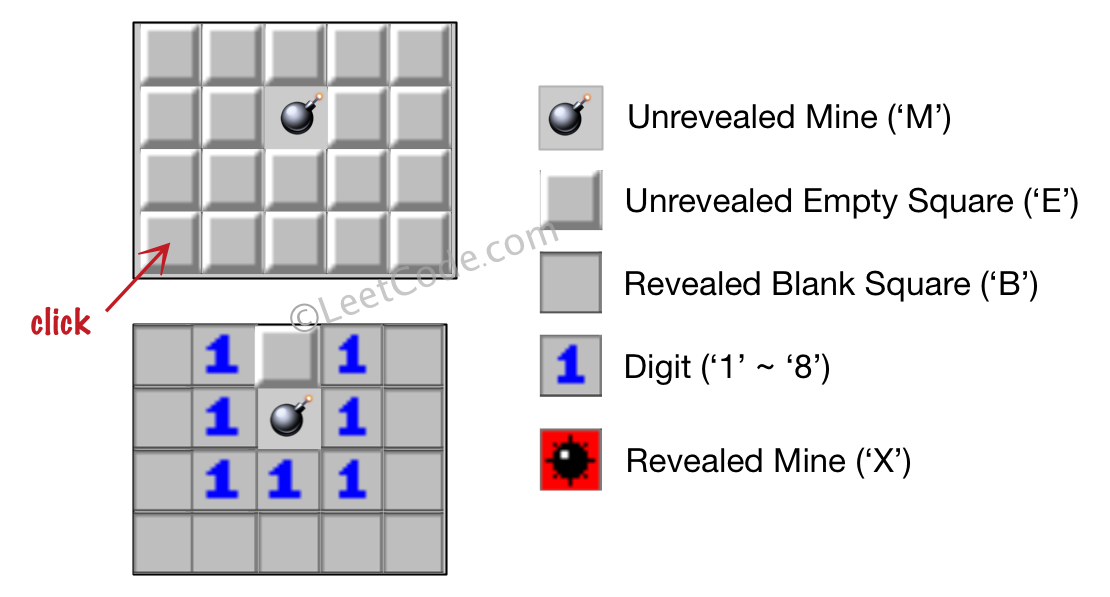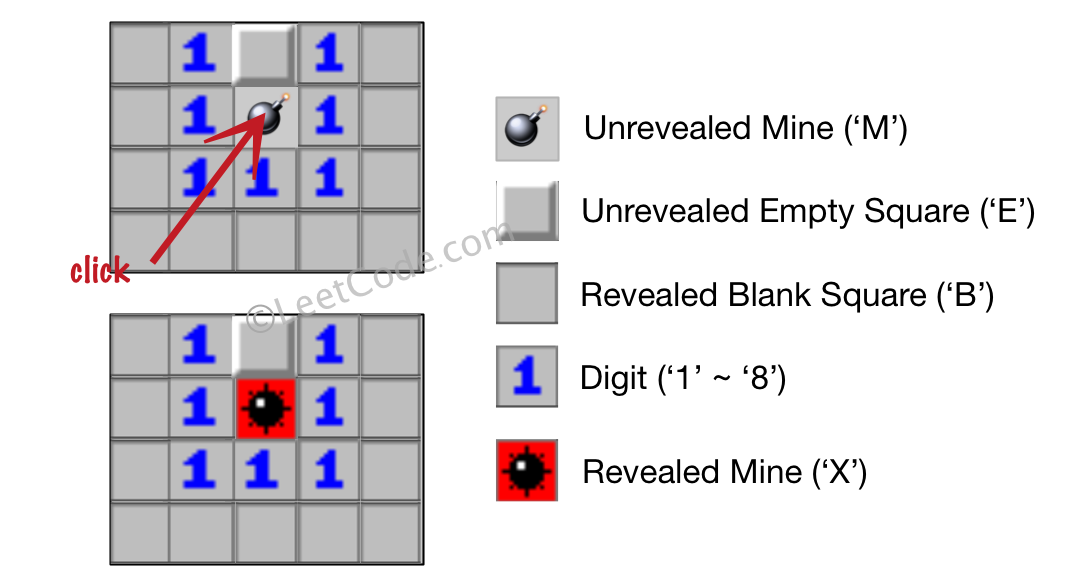Let‘s play the minesweeper game (Wikipedia, online game)!
You are given a 2D char matrix representing the game board. ‘M‘ represents an unrevealed mine, ‘E‘ represents an unrevealed empty square, ‘B‘ represents a revealed blank square that has no adjacent (above, below, left, right, and all 4 diagonals) mines, digit (‘1‘ to ‘8‘) represents how many mines are adjacent to this revealed square, and finally ‘X‘ represents a revealed mine.
Now given the next click position (row and column indices) among all the unrevealed squares (‘M‘ or ‘E‘), return the board after revealing this position according to the following rules:
Example 1:
Input: [[‘E‘, ‘E‘, ‘E‘, ‘E‘, ‘E‘], [‘E‘, ‘E‘, ‘M‘, ‘E‘, ‘E‘], [‘E‘, ‘E‘, ‘E‘, ‘E‘, ‘E‘], [‘E‘, ‘E‘, ‘E‘, ‘E‘, ‘E‘]] Click : [3,0] Output: [[‘B‘, ‘1‘, ‘E‘, ‘1‘, ‘B‘], [‘B‘, ‘1‘, ‘M‘, ‘1‘, ‘B‘], [‘B‘, ‘1‘, ‘1‘, ‘1‘, ‘B‘], [‘B‘, ‘B‘, ‘B‘, ‘B‘, ‘B‘]] Explanation:

Example 2:
Input: [[‘B‘, ‘1‘, ‘E‘, ‘1‘, ‘B‘], [‘B‘, ‘1‘, ‘M‘, ‘1‘, ‘B‘], [‘B‘, ‘1‘, ‘1‘, ‘1‘, ‘B‘], [‘B‘, ‘B‘, ‘B‘, ‘B‘, ‘B‘]] Click : [1,2] Output: [[‘B‘, ‘1‘, ‘E‘, ‘1‘, ‘B‘], [‘B‘, ‘1‘, ‘X‘, ‘1‘, ‘B‘], [‘B‘, ‘1‘, ‘1‘, ‘1‘, ‘B‘], [‘B‘, ‘B‘, ‘B‘, ‘B‘, ‘B‘]] Explanation:

Note:
题目属于背景复杂,但本质不难的类型。因为没玩过扫雷游戏,所以看了半天题目,了解了规则后,可以发现属于传统的广度优先搜索问题。基础实现的时候,会超时间。
最后改了半天边缘问题,仍然是超时。最后,看了英文版leetcode的讨论区,发现就一行神秘的代码,就可以解决重复处理节点的问题~~~
class Solution { public: vector<vector<char>> updateBoard(vector<vector<char>>& board, vector<int>& click) { int row = click[0]; int col = click[1]; int maxRow = board.size(); int maxCol = board[0].size(); vector<vector<char>> results; for(int i = 0; i < maxRow; i++) { vector<char> temp(board[i]); results.push_back(temp); } // M if(results[row][col] == ‘M‘) results[row][col] = ‘X‘; // E else if(results[row][col] == ‘E‘) { queue<pair<int, int>> eNodes; eNodes.push(make_pair(row, col)); while(!eNodes.empty()) { pair<int, int> curr = eNodes.front(); eNodes.pop(); row = curr.first; col = curr.second; results[row][col] = ‘0‘; // check neighbors for(int i = -1; i <= 1; i++) { int currRow = row + i; if(currRow < maxRow && currRow >= 0) { for(int j = -1; j <= 1; j++) { if(i == 0 && j == 0) continue; int currCol = col + j; if(currCol < maxCol && currCol >= 0) { // M add to counter if(results[currRow][currCol] == ‘M‘) { results[row][col]++; } } } } } // around no M if(results[row][col] == ‘0‘) { results[row][col] = ‘B‘; // add neighbors to deal for(int i = -1; i <= 1; i++) { int currRow = row + i; if(currRow < maxRow && currRow >= 0) { for(int j = -1; j <= 1; j++) { if(i == 0 && j == 0) continue; int currCol = col + j; if(currCol < maxCol && currCol >= 0) { // E add to deal if(results[currRow][currCol] == ‘E‘) { eNodes.push(make_pair(currRow, currCol)); results[currRow][currCol] = ‘B‘; // optimize to avoid repeatly added } } } } } } }// end of dealing } return results; } };
原文:https://www.cnblogs.com/niuxu18/p/note_leetcode_7.html